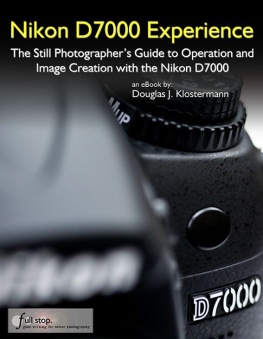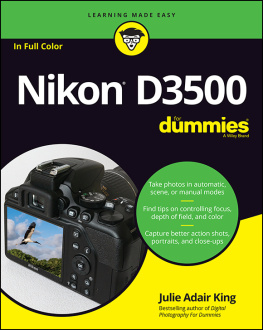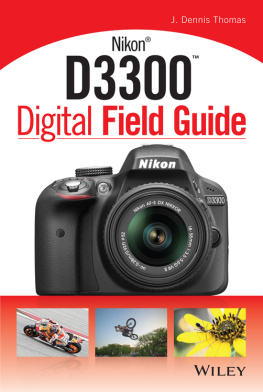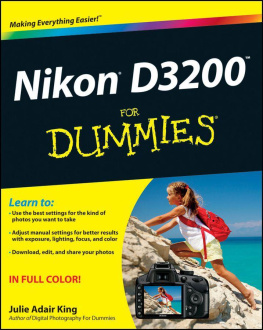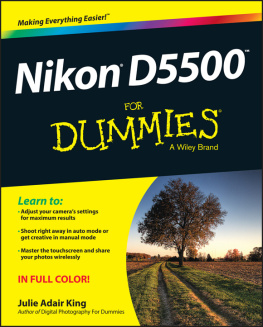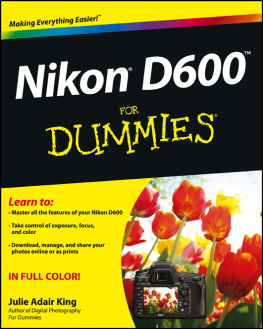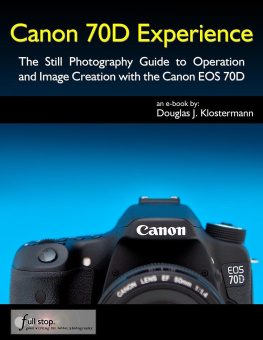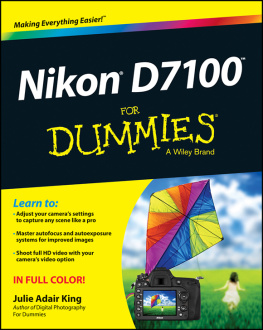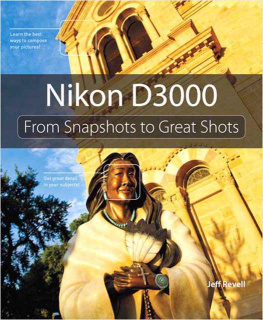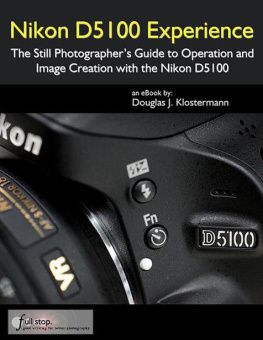Nikon D7000Experience
The Still Photographers Guide
to Operation and Image Creation
with the Nikon D7000
Douglas J. Klostermann
Published by Douglas J. Klostermann / FullStop
Smashwords Edition
Version 2.4 - October 2011
ISBN: 978-1-4524-1742-4
Copyright 2011 Douglas J. Klostermann
All rights reserved. This e-book is licensedfor your personal enjoyment only and may not be re-sold,distributed, file-shared, torrented, or given away. No part of thisbook may be reproduced or transmitted in any form or by any means,electronically or in print, without expressed permission from theauthor. Every effort has been made to make this e-book as accurateas possible, but no warranty of fitness is implied. The informationis provided on an as-is basis. The author shall have no liabilityor responsibility with respect to any loss or damages arising fromthe information provided in this e-book including but not limitedto the use of any of the materials or methods described, theproducts, retailers, Internet web sites, or links provided.
All contents including cover design, text,and photographs, with the exception of products, logos and contentshown in Internet screenshots, are copyright by the author. Allproducts, logos and content of screenshots are property of therespective companies and websites. Use of terms which aretrademarks or service marks in this e-book should not be regardedas affecting the validity of any trademark or service mark.
Copyright 2011 Douglas J. Klostermann
Cover design and photograph by the author.
Authors website: www.dojoklo.com
Authors blog: http://blog.dojoklo.com/
Published by FullStop. good writing for betterphotography
A division of Douglas J.Klostermann PhotographyCambridge, MA 02138USA
http://www.dojoklo.com/Full_Stop/
CONTENTS
1. INTRODUCTION
The introduction of the Nikon D7000 createdgreat excitement, especially for photographers who were awaiting asuccessor to the D90. Its features and capabilities exceededexpectations by providing users with an advanced, moresophisticated autofocus system, a ruggedly built body with aprofessional sturdy feel, and an improved sensor, processor, andexposure metering system. Its great image quality at high ISOsettings, dual memory card slots, big and bright viewfinder, highcapacity battery, video capabilities, customization options, andfast continuous frame rate make it one of the finest dSLR camerasin its class. Not only is the Nikon D7000 a significant upgrade tothe D90, but it also rivals the more expensive semi-professionalNikon D300s in performance, construction, and image quality.
The Nikon D7000 is clearly a powerful,advanced tool for digital photography: 16.2 megapixel sensor, 39point autofocus system, 6 frames per second (fps) continuousshooting speed, and high ISO capabilities. It is fully capable ofcapturing professional quality images in most any situation youwish to use it. But it is merely a tool.
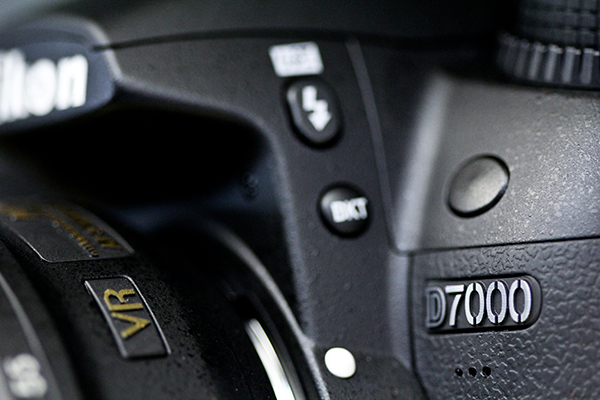
Figure 1 Detail of the Nikon D7000 digital SLR
It is up to you to make use of its featuresand capabilities to create the images you envision. While thecameras manual can tell you about all the settings and controlsand how they function, this guide will build upon that and tell youwhen and why you want to use them. Every button, menu item, andCustom Setting of the D7000 is there for a reason: to help youcapture the images you want. Some of them are more useful todifferent types of photographers and shooting situations and youdont necessarily need to learn and use them all, but this guideshould help to give you the knowledge to confidently use the onesthat turn your Nikon D7000 into an image capturing tool that worksbest for you.
Learning to use and get the most out of anadvanced dSLR camera like the D7000 takes time, practice, patience,mistakes, and experimentation. If you are not yet familiar with allthe controls of a dSLR and the exposure concepts of digitalphotography, dont expect to just pick it all up at once, in one ortwo readings of a single book. (In fact, you wouldnt want to, asthe never ending journey of learning and mastering photography is abig part of what its all about!) Try not to become frustrated whenyou dont quite understand something or arent yet getting theresults you desire. Instead learn the controls, functions,settings, and concepts little by little, try them out in real lifeshooting situations, and return to this guide, the manual, andother photography books to address questions and problems youencounter. Continue to learn and to photograph often and it shouldall begin to come together, sometimes slowly and sometimes in rapidspurts of discovery and understanding.
If you have upgraded from an older dSLR tothe D7000, you are in for a treat. Its additional features andcapabilities will more easily help you to capture images andphotographs that you were limited in consistently attaining before.Its autofocus system and rapid continuous shooting speed inparticular will help you capture sharp images of subjects andmoments that previously you may have missed. If you are new to dSLRphotography, you have perhaps jumped right into the proverbial deepend of the pool by starting out with the advanced D7000! But dontworry, this book will help guide you through its features,controls, and capabilities. Be sure to take it slowly and patientlyand start with the basic features and concepts that I will explain.With practice and experience you will soon be shooting withconfidence and can begin to take advantage of the cameras moreadvanced functions.
Using This Guide
There are many different ways to use adigital SLR (dSLR) camera and its controls to capture images, andIm not going to attempt to explain them all. I am going toconcentrate on the ways that I believe are the most practical,useful, and effective. The settings and techniques I discuss applyto many types of general photography, including most travelphotography. I will point out other options for users who mightwish to work differently and I encourage you to experiment and findthe techniques that work best and are most comfortable or intuitivefor you. If you typically shoot very specifically, say macrophotography or studio photography with complex lighting, some ofwhat I discuss may not apply. But if you are that specialized, Imsure you are skilled enough to know when and how to adapt what Isay!
Since this guide is intended to help you getthe most out of your D7000, I will not discuss or go into detailabout all of the automatic features or Auto and Scene Modes. TheD7000 is a highly sophisticated tool that deserves to be used toits full potential, and that involves taking control of the cameraand its functions, which means taking it off Auto, off Program, offautomatically selected auto-focus points, off Auto ISO. While thismay be more challenging at first, these are the techniques that arenecessary to take full advantage of the capabilities of any dSLRincluding the D7000, and will lead you to having more control andconsistency over your image making. Hopefully this will inevitablylead to better images!
This guide is intended to be used with thecamera in your hands. That is the best way to directly see andunderstand what is being explained. It is also intended to be usedin conjunction with and in addition to the cameras manual, not tocompletely replace it, so every bit of information in the NikonD7000 Users Manual will not be repeated here. Among theofficial manuals often brief descriptions and sometimesfrustratingly incomplete explanations, there is some very valuableinformation, as well as the basics for buttons, controls, and howto change all the settings. Note that the
Next page
